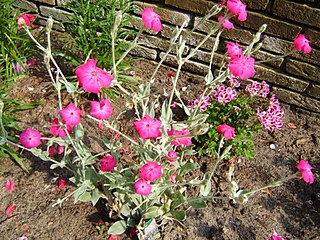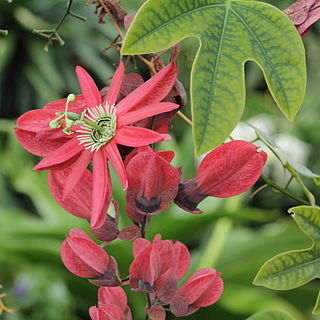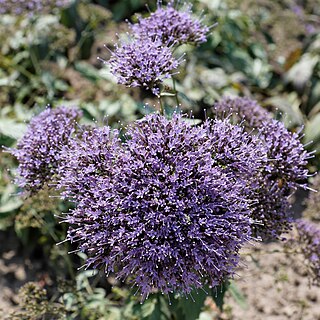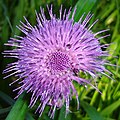
Pinus parviflora, also known as five-needle pine, or Japanese white pine, is a pine in the white pine group, Pinus subgenus Strobus, native to Japan.

Phoenix roebelenii, with common names of dwarf date palm, pygmy date palm, miniature date palm or robellini palm, is a species of date palm native to southeastern Asia, from southwestern China, northern Laos and northern Vietnam.

Abutilon pictum, syn. Abutilon striatum (disputed), is a species of flowering plant in the family Malvaceae. It is native to southern Brazil, Argentina, Paraguay and Uruguay. The plant has become naturalised in Central America, and is used in horticulture. Common names include redvein abutilon, red vein Indian mallow, redvein flowering maple, Chinese-lantern and red vein Chinese lanterns.

Jasminum nudiflorum, the winter jasmine, is a slender, deciduous shrub native to China. The flower's blossoming peaks right after winter, which is why it is also named Yingchun (迎春) in Chinese, which means "the flower that welcomes Spring". It is widely cultivated as an ornamental and is reportedly naturalized in France and in scattered locations in the United States.

Silene coronaria, the rose campion, is a species of flowering plant in the family Caryophyllaceae, native to Eurasia. Other common names include dusty miller, mullein-pink and bloody William. In the United Kingdom it is still widely referenced under its synonym Lychnis coronaria.

Kalmia angustifolia is a flowering shrub in the family Ericaceae, commonly known as sheep laurel. It is distributed in eastern North America from Ontario and Quebec south to Virginia. It grows commonly in dry habitats in the boreal forest, and may become dominant over large areas after fire or logging. Like many plant species of infertile habitats it has evergreen leaves and mycorrhizal associations with fungi. It is also found in drier areas of peat bogs.

Helictotrichon sempervirens, the blue oat grass, is a species of flowering plant in the true grass family, Poaceae, native to central and southwest European grasslands. It is a bunchgrass often used as an ornamental grass in garden design and landscaping.

Phlox subulata the creeping phlox, moss phlox, moss pink or mountain phlox, is a species of flowering plant in the family Polemoniaceae, native to eastern and central USA, and widely cultivated.

Viburnum plicatum is a species of flowering plant in the family Adoxaceae, native to mainland China, Korea, Japan, and Taiwan. The Latin specific epithet plicatum means "pleated", referring to the texture of the leaves.

Eutrochium maculatum, the spotted joe-pyeweed, is a North American species of flowering plant in the family Asteraceae. It is widespread through much of the United States and Canada. It is the only species of the genus Eutrochium found west of the Great Plains.

Teucrium fruticans is a species of flowering plant in the mint family Lamiaceae, native to the western and central Mediterranean. Growing to 1 m (3 ft) tall by 4 m (13 ft) wide, it is a spreading evergreen shrub with arching velvety white shoots, glossy aromatic leaves and pale blue flowers in summer.

Sorbaria sorbifolia, the false spiraea, is a species of flowering plant in the family Rosaceae. The common name is also spelled false spirea. Other common names include false goat's beard, sorb-leaved schizonotus, Ural false spirea, and in Chinese: 珍珠梅; pinyin: zhen zhu mei; lit. 'pearl plum'.

Geranium psilostemon, commonly called Armenian cranesbill, is a species of hardy flowering herbaceous perennial plant in the genus Geranium, family Geraniaceae. It is native to Turkey, Armenia, Azerbaijan, and the Russian Federation. Forming a large clump to 120 cm (47 in) tall, it has glowing reddish purple colored flowers with prominent dark centres, and divided leaves tinted red in Autumn. It is cultivated as a garden subject, and a number of different cultivars exist. G. psilostemon has the UK’s hardiest rating, surviving temperatures as low as −20 °C (−4 °F).

Ranunculus aconitifolius, the aconite-leaf buttercup or bachelor's buttons, is a species of flowering plant in the buttercup family Ranunculaceae, native to central Europe. Growing to 60 cm (24 in) high by 40 cm (16 in) broad, this herbaceous perennial has slightly hairy palmate leaves up to 20 cm (8 in) long, and loose panicles of white, saucer-shaped flowers in spring.

Passiflora racemosa, the red passion flower, is a species of flowering plant in the family Passifloraceae, native to Brazil. It is an evergreen climber growing to 5 m (16 ft), with simple or 3-lobed leaves to 10 cm (4 in) long, and vivid red flowers borne in summer. The flowers are 12 cm (5 in) in diameter, with purple and white coronas. They are followed by oblong green fruits.

Acer palmatum, commonly known as Japanese maple, palmate maple, or smooth Japanese maple (Japanese: irohamomiji, イロハモミジ, or momiji,, is a species of woody plant native to Japan, Korea, China, eastern Mongolia, and southeast Russia. Many different cultivars of this maple have been selected and they are grown worldwide for their large variety of attractive forms, leaf shapes, and spectacular colors.

Scilla bifolia, the alpine squill or two-leaf squill, is a herbaceous perennial plant growing from an underground bulb, belonging to the genus Scilla of the family Asparagaceae.

Heliopsis helianthoides is a species of flowering plant in the family Asteraceae, known by the common names rough oxeye, smooth oxeye and false sunflower. It is native to eastern and central North America from Saskatchewan east to Newfoundland and south as far as Texas, New Mexico, and Georgia.

Pleroma urvilleanum, synonym Tibouchina urvilleana, is a species of flowering plant in the family Melastomataceae, native to Brazil.

Trachelium caeruleum, common name blue throatwort, is a species of flowering plant in the family Campanulaceae native to the Mediterranean, where its native range includes Algeria, Morocco, Portugal, Spain, and Sicily. It has also become naturalized in a few areas, including New Zealand, the Azores, and parts of mainland Europe.






















